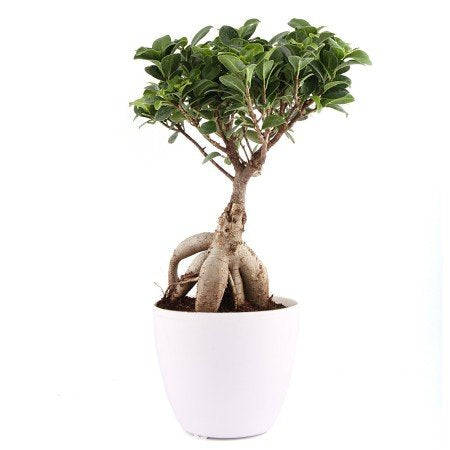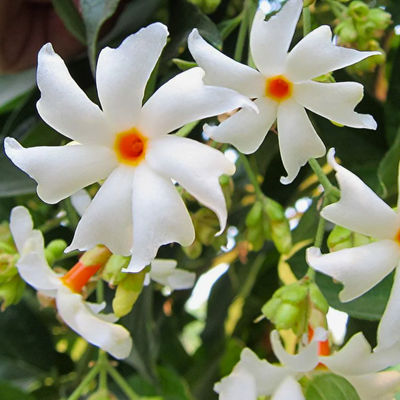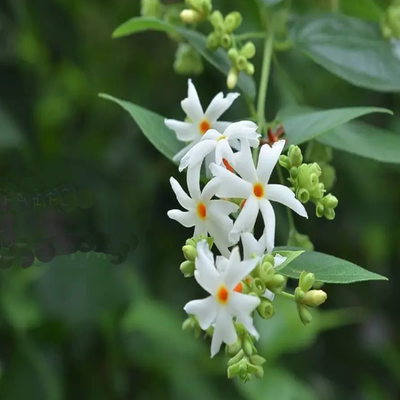

Bonsai Ficus Ginseng Live Plant with pot
Guaranteed Safe Checkout
Green Paradise Offers Beautiful
Bonsai Ficus Ginseng Plant
About Bonsai Ficus Ginseng Plant
The Bonsai Ficus Ginseng, also known as Ficus macrocarpa or Ginseng Ficus, is a popular and visually appealing bonsai tree. It is a variety of the Ficus family, which is native to Southeast Asia. The plant is named "Ginseng" due to its thick and bulbous root system, resembling the shape of a ginseng root.
Here are some key characteristics and care guidelines for the Bonsai Ficus Ginseng:
Appearance:
-
The Ficus Ginseng has thick, aerial roots that extend above the soil, giving it an exotic and dramatic appearance.
-
The leaves are dark green and glossy, with an oval shape and pointed tip.
-
The tree develops a thick, gnarled trunk over time, adding to its visual appeal.
Lighting:
-
This bonsai tree thrives in bright, indirect light.
-
It should be placed near a window where it can receive plenty of filtered sunlight.
-
However, it's important to avoid exposing it to direct sunlight, as it can scorch the leaves.
Temperature:
-
The Ficus Ginseng prefers a warm and tropical climate.
-
It can tolerate temperatures between 60-75°F (15-24°C) but should be protected from cold drafts or extreme temperature fluctuations.
Watering:
-
Proper watering is crucial for the health of your Ficus Ginseng.
-
It prefers slightly moist soil, but overwatering should be avoided as it can lead to root rot.
-
Water the plant thoroughly when the top inch of soil feels dry,
-
but ensure that excess water can drain away from the pot.
Humidity:
-
As a tropical plant, the Bonsai Ficus Ginseng appreciates moderate to high humidity levels.
-
If the air in your home is dry, you can increase humidity by placing the pot on a tray with water and pebbles or using a humidifier.
Pruning and Shaping:
-
Regular pruning is necessary to maintain the desired shape and size of the bonsai tree.
-
Trim back new growth to encourage branching and maintain the tree's proportions.
-
Wiring can also be used to shape the trunk and branches, but care should be taken to avoid excessive pressure that may damage the tree.
Fertilization:
-
Ficus Ginseng bonsai benefits from regular fertilization during the growing season, typically spring and summer.
-
Use a balanced, water-soluble fertilizer specifically designed for bonsai trees, following the package instructions for dosage.
Repotting:
-
Repotting is usually done every two to three years, or when the root system becomes crowded.
-
Spring is the best time for repotting.
-
Use a well-draining bonsai soil mix, and prune back some of the roots to maintain the tree's size and promote healthy growth.
Pests and Diseases:
-
While the Bonsai Ficus Ginseng is generally hardy,
-
it can be susceptible to common houseplant pests like aphids, scale insects, and spider mites.
-
Regularly inspect the leaves and branches for any signs of pests or diseases, and take appropriate measures, such as using insecticidal soap or neem oil, if necessary.
With proper care and attention, the Bonsai Ficus Ginseng can be a stunning addition to your home or office. Its unique root system and beautiful foliage make it a captivating bonsai tree that brings a touch of nature indoors.
Ficus Ginseng facts
Crucial Ficus Name – Ficus ‘ ginseng ’
Scientific – Ficus macrocarpa
Family – Moraceae( mulberry family)
Type – inner factory And Outdoor Plant
Soil – inner factory soil blend, well-drained
Exposure – abundant circular
light leafage – evergreen
Watering: moderate
Difficulty – easy to Grow
How To Grow Bonsai Ficus Ginseng Plant
Growing a Bonsai Ficus Ginseng plant requires patience, attention to detail, and proper care. Then are some guidelines to help you with the process's amazing effect.
Select a healthy plant:
-
Choose a Ficus Ginseng plant with a thick, well-developed trunk and good root system.
-
Look for a plant with aerial roots as they add to the bonsai's aesthetic appeal.
Potting:
-
Use a well-draining bonsai pot or container with drainage holes to prevent waterlogging.
-
Place a layer of small stones or bonsai soil at the bottom for adequate drainage.
Soil:
-
Ficus Ginseng prefers well-draining soil.
-
A suitable mix can consist of equal parts of Akadama soil, pumice, and lava rock.
-
This combination allows for good water retention while also providing necessary aeration for the roots.
Pruning and shaping:
-
Bonsai Ficus Ginseng plants require regular pruning and shaping to maintain their desired size and form.
-
Use sharp bonsai scissors or shears to trim back new growth and maintain the shape you desire.
-
Prune the roots occasionally by removing small amounts of the root ball to prevent them from becoming too dense.
Watering:
-
Water the plant thoroughly whenever the top inch of the soil feels slightly dry.
-
Ensure that the entire root ball is watered evenly.
-
Refrain from overwatering to prevent root rot.
-
It's a good idea to use a moisture meter or stick your finger into the soil to gauge moisture levels accurately.
Light and temperature:
-
Ficus Ginseng prefers bright, indirect light.
-
Place your bonsai near a window that receives filtered sunlight.
-
Avoid placing it in direct sun as it may scorch the leaves.
-
Maintain a temperature range between 60-75°F (15-24°C) throughout the year.
-
shield the Plant from chilly winds and sharp temperature changes.
Humidity:
-
Ficus Ginseng enjoys moderate humidity.
-
To increase humidity levels around the plant, you can place a tray filled with water and pebbles beneath the bonsai pot.
-
As the water evaporates, it'll produce a further sticky microclimate.
Fertilization:
-
Bonsai Ficus Ginseng plants benefit from regular fertilization during the growing season (spring to fall).
-
Use a balanced, water-soluble bonsai fertilizer diluted to half strength and apply it every two to four weeks.
-
Reduce or stop fertilizing during the winter dormancy period.
Repotting:
-
Report your Ficus Ginseng bonsai every two to three years to prevent the roots from becoming pot-bound.
-
Spring is the ideal time for repotting.
-
Trim back some of the roots and replace the old soil with fresh bonsai soil mix.
-
Prune the top growth to balance the root-to-foliage ratio.
Pest control:
-
Inspect your bonsai regularly for pests such as aphids, scales, or spider mites.
-
Treat infestations promptly using insecticidal soap or other appropriate methods.
-
Keep an eye out for signs of disease or fungus and address them promptly.
Remember that growing a bonsai requires time and dedication. Regular care, proper pruning, and attention to its needs will help you achieve a beautiful and healthy Bonsai Ficus Ginseng plant over time.


















